Pain in your toe or the ball of your foot – lesser toe deformities
Pain in your toe or the ball of your foot – lesser toe deformities
What are lesser toe deformities?
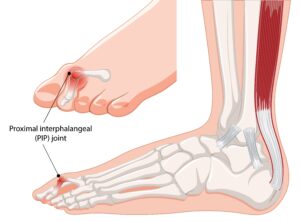
Lesser toe deformities are changes in the shape of any of the four smaller toes of your foot.
The most common lesser toe deformities are hammer toe (see image right), claw toe, mallet toe and overlapping toes (see images below).
The deformities can occur due to an imbalance between the muscles and tendons within your foot that hold your toes straight. These changes are usually flexible but can become fixed in their new position over time. They cause pain in the toe itself or discomfort when wearing shoes due to friction and pressure of the toes against the shoe. These changes are commonly seen in the second toe but can affect any of the lesser toes.
What are the signs and symptoms of lesser toe deformities?
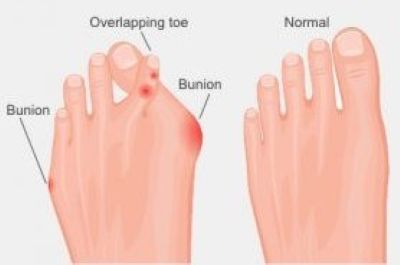 You may experience any or all of the following:
You may experience any or all of the following:
- pain and callous and/or corns over the top of the joints of the toes
- deformity in the shape of toe
- shoes becoming uncomfortable over the toes
- pain and callous underneath the tip of the toe
- redness and swelling around the joint
- stiffness in the joints of the toe
- difficulty walking.
Common lesser toe deformities
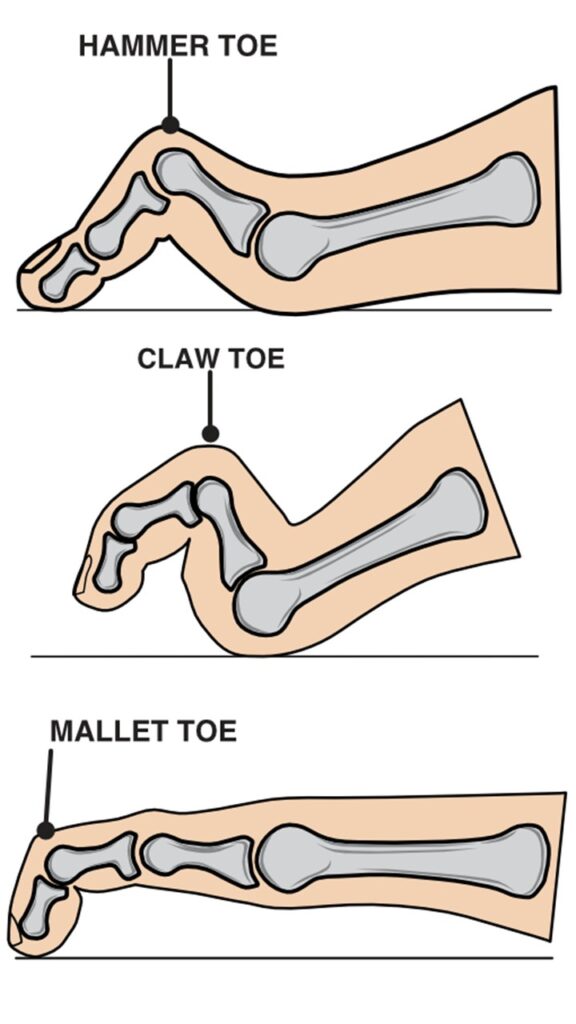 Hammer toe – a bend develops in the first joint of the toe, causing the end of the toe to touch the ground and the bent joint to rub against the shoes. Over time if left untreated, muscles and tendons in your toes tighten, freezing your toes in a curled shape. Due to the change in shape, a corn/callous can develop on the top and/or tip of the toe. Hammer toe is most commonly seen in the second toe but can occur in any of the smaller toes. A hammer second toe is often seen with a bunion deformity.
Hammer toe – a bend develops in the first joint of the toe, causing the end of the toe to touch the ground and the bent joint to rub against the shoes. Over time if left untreated, muscles and tendons in your toes tighten, freezing your toes in a curled shape. Due to the change in shape, a corn/callous can develop on the top and/or tip of the toe. Hammer toe is most commonly seen in the second toe but can occur in any of the smaller toes. A hammer second toe is often seen with a bunion deformity.
Claw toe – is where the toes curl downward, resembling a claw. This happens because the joints in the toe bend abnormally, with the joint closest to the foot pointing upwards and the other joints bending downwards. Claw toes can be painful and may lead to corns or calluses on the top or tip of the toe due to pressure from shoes. If left untreated, the severity of the deformity can increase over time.
Mallet toe – affects the joint closest to the tip of the toe causing it to bend downward. This can lead to pain, calluses or corns over the top and/or tip of the toe. It commonly affects the second toe, but can occur in other lesser toes as well. If left untreated it can become fixed over a period of time.
Overlapping toe – when one of your toes, usually the big toe or smallest toe, extends over the adjacent toe. A similar condition, called an underlapping toe, develops when your toe extends under the adjacent toe. An overlapping toe is often seen alongside a bunion. Overlapping toe can lead to discomfort and callous build up over the top of the joints as well as increased pressure between and around the toes.
What causes lesser toe deformities?
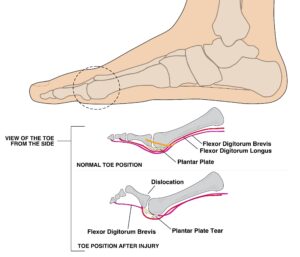 Changes to the shape of your toes occur as a result of an imbalance between the muscles and tendons which hold your toes straight and those that bend the toes. There can be several reasons for these changes including:
Changes to the shape of your toes occur as a result of an imbalance between the muscles and tendons which hold your toes straight and those that bend the toes. There can be several reasons for these changes including:
- footwear that doesn’t fit well or cramps the toes together
- inflammatory conditions, such as rheumatoid arthritis
- trauma to the toe
- bunions
- neuromuscular conditions, such as cerebral palsy, Charcot-Marie-Tooth disease or muscular dystrophy
- peripheral neuropathy (pain, numbness, or tingling in the feet, caused by factors such as diabetes, injury, cancer, and certain cancer treatments) leading to a muscle imbalance.
What can I do to relieve the pain of a lesser toe deformity?
To improve comfort, you need to relieve the pressure on the toes. Making changes to your lifestyle so you reduce aggravating activities is key. Only you can do this.
Things to try:
- raising your foot on a stool and resting it when you can
- putting an ice pack (or bag of frozen peas) in a towel on the painful area for up to 20 minutes every two to three hours
- shoes with cushioned heels and good arch support
- insoles in your footwear
- regular stretching and foot exercises
- exercises which put no pressure on your feet, such as swimming
- losing weight if you’re overweight or obese.
Strapping
Strapping or taping can be a useful short term treatment to help reduce your symptoms, by supporting and stabilising your toe, guiding it to an improved position. Taping is only a short term treatment after a sprain or injury to heal the plantar plate ligament – we recommend it’s used until your pain levels decrease. Keep the tape in place for a maximum of three to four days, it may need to be replaced more frequently to remain effective.
Use rigid zinc oxide strapping tape which is available in most pharmacies or can be bought online. Cut strips of tape to size first using your hand as a reference. Starting at the tip of your longest finger run the tape to the base of your palm. This should give you the correct amount or tape. Next cut the tape lengthwise into two equal sized pieces. Take one of the pieces and stick it back on the roll for later. Position the tape on your toe as shown in the image below.
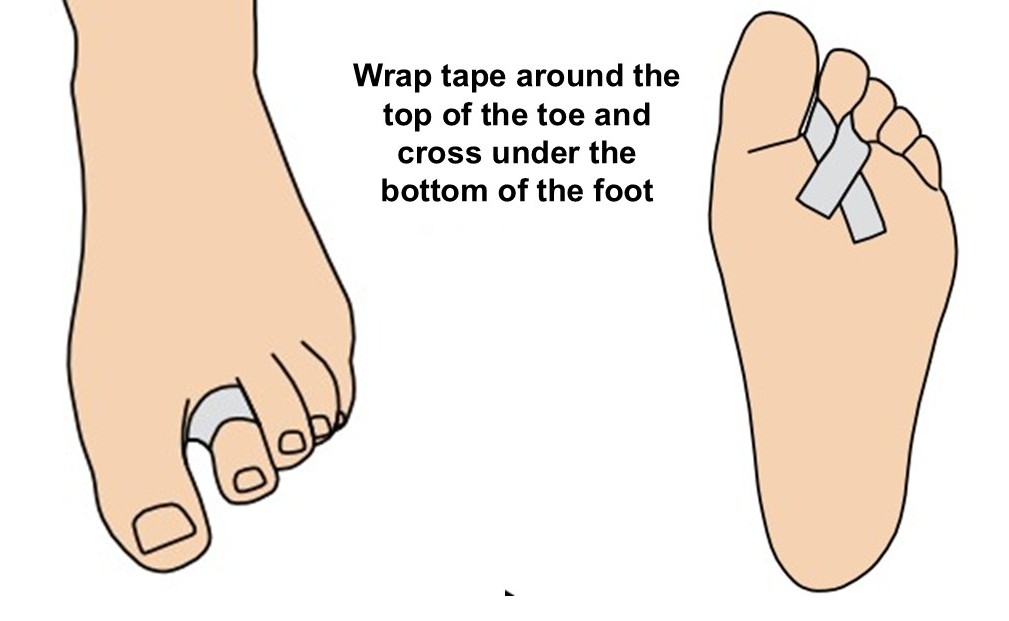
Things to avoid:
- walking or standing for long periods
- wearing high heels or tight, pointy shoes
- wearing flip-flops or backless slippers
- walking barefoot on hard surfaces.
What shoes should I wear if I have a lesser toe deformity?
It’s important to choose footwear that is deep enough to accommodate the deformity and which has a soft material as the upper. Softer materials can mould around the toes more easily than hard leathers.
If your shoe is not deep enough, it will rub on the prominent joints causing the surrounding skin to become red, swollen and in some cases the skin can blister or become thickened. Sometimes a fluid filled sac, called a bursa, can develop over the joint. The bursa can also become inflamed and painful.

Ankle, foot and toe rehabilitation exercises
The video exercises shown below will help to improve your pain over a period of time. Watch the video first, then try the exercise. There are six videos to try – go through to the next one below by clicking the arrow on the right of the video. All videos provided and shared with kind permission of, and thanks to, the Musculoskeletal Podiatry team at NHS Lanarkshire.
You need the use of a clear space of wall, a small towel, a small plastic bottle of water, a sports resistance band and a sports therapy ball. If you do not have a sports resistance band or sports therapy ball (also known as a soft spiked massage ball) these can be purchased relatively inexpensively online. If cost is an issue, focus on the exercises which do not use that equipment.
Important – pain levels: the NHS uses a pain scale where pain is measured from 0-10 (zero being no pain and 10 representing the worst pain you could imagine).
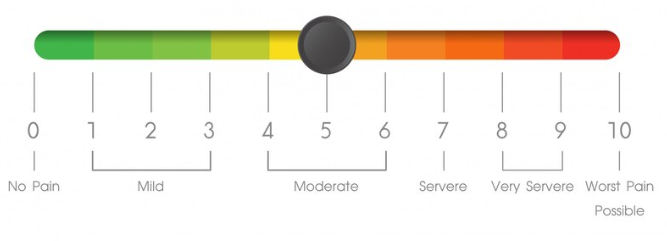
If you can identify the level of pain you are experiencing, you will find out if you are in the green, amber or red zone.
When you are completing your rehabilitation exercises it is often best to work within the green (and sometimes amber zones depending on what you deem is an acceptable level of pain) both during the exercises and within 48 hours of completing your exercises.
The best way to move down to the green zone is by pacing and spacing your activity. If you find yourself in the red zone you are likely pushing yourself too hard and the pain may flare up.
If you notice a large increase in your pain after doing the exercises, or you find that after six to twelve weeks there is no noticeable changes in your day to day symptoms, then please contact your GP or self-refer to our MSK podiatry team.